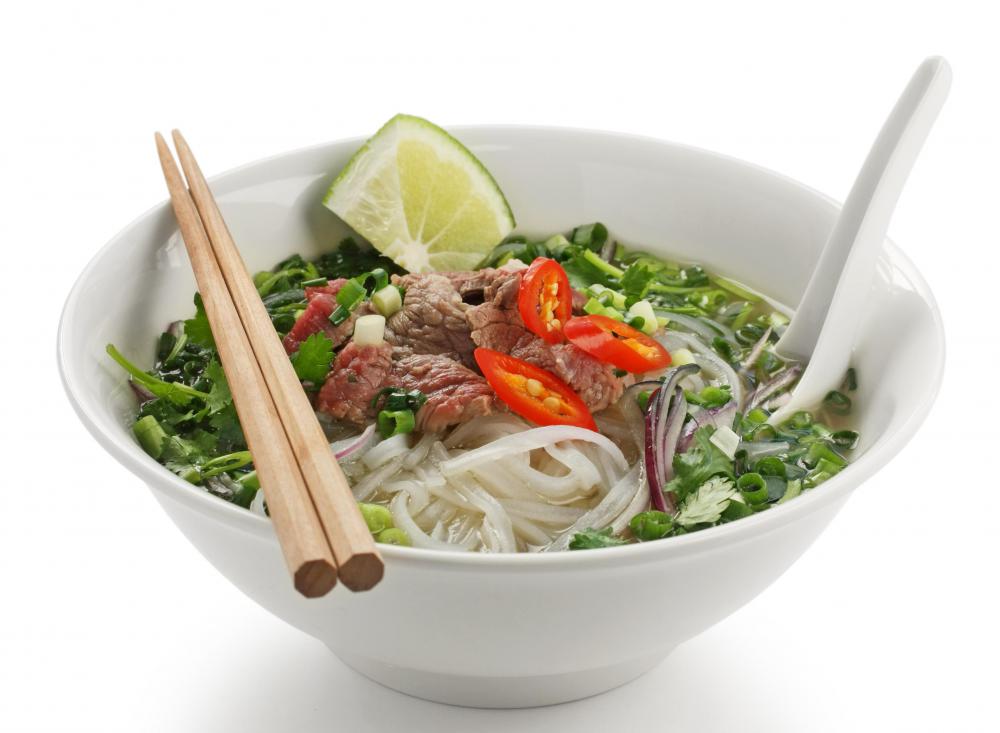At DelightedCooking, we're committed to delivering accurate, trustworthy information. Our expert-authored content is rigorously fact-checked and sourced from credible authorities. Discover how we uphold the highest standards in providing you with reliable knowledge.
What is Thai Basil?
Thai basil (Thai name, bai horapa), also known as Oriental basil or Asian basil, is a cultivar of sweet basil commonly used in the cuisines of Thailand, Vietnam, Cambodia, and Laos. Compared to the common Mediterranean sweet basil, it has a more pronounced licorice or anise flavor. Because of this, it is sometimes referred to as anise or licorice basil, but it should not be confused with the American cultivars of these basils. The flavor is peppery and warm, and although there is a difference between Thai basil and common sweet basil, they can be substituted for each other in most recipes. The Thai variety tends to hold its flavor better when cooked than its Mediterranean cousin does.
The leaves of this basil are deep green, smaller than those of Western basil, and arranged on purple-hued stems. The flowers, which are edible as well, are red-purple and licorice flavored. They form in a cluster, not on a spike, unlike those of common basil. These flowers make an attractive plate garnish or colorful addition to green salads.

Thai basil can be found fresh in some markets, particularly in areas where there are sizable Asian populations. It is not hard to grow, however, and makes a lovely addition to a backyard herb, flower, vegetable, or ornamental garden. The Siam Queen cultivar, popular among home gardeners, can be started from seed, and does very well as a container plant. Indoors, gardeners should place it in or near a sunny window, make sure its soil is moist but not soggy, and provide a pot large enough so that the plant does not become root-bound.

Outdoors, Thai basil likes well-drained soil. It is sensitive to frost and should not be planted outside until both day- and nighttime temperatures are fixed above 50°F (10°C). Although it will grow happily in full sun, it requires only 4 to 6 hours of sunlight a day, and will do fine in filtered or indirect light. It forms a leafy little bush, approximately 12 to 18 inches (30 to 45 cm) both tall and wide.

Planted in the garden as a companion herb, this basil is thought to repel aphids, tomato horn worms, and certain mites. New shoots can be pinched back to encourage more lush growth and prevent flowering, if desired. Leaves can be air-dried or microwave-dried to preserve them.
When harvesting Thai basil, gardeners should remove single leaves only as they need them. The top section of a stem should be pinched off, stopping just at the intersection where two leaves emerge. This will prompt the plant to produce new growth branching off from the place where the gardener removed the stem. Removing leaves individually will not achieve the same result. Cooks should rinse the leaves in cool water to remove dirt or grit and pat dry between paper towels before using them.

Thai basil is considerably stronger in flavor than Mediterranean basil, so cooks should make adjustments to the amount used if substituting one for the other. The herb can be used for Thai, Indian, and Italian recipes. Fresh, it can be added to salads, and either the fresh or dried forms can be used to flavor soups, pasta, and vegetable dishes.
AS FEATURED ON:
AS FEATURED ON:















Discussion Comments
@anon36331-- Thai basil is good for stomach ailments, the common cold and memory.
When I have a sore throat and cough, I make a tea with Thai basil, ginger and honey. It makes me feel better instantly.
I believe that Thai basil is also used to make topical products that relieve symptoms of insect bites.
@donasmrs-- No, they're not. They both belong to the basil family but are different variety.
I believe that the Indian basil doesn't have any purple and the leaves are hairy. Thai basil looks different, is more pleasant to eat (no hairs on the leaves) and is more fragrant.
As far as I know, Thai basil herb is mostly used for cooking whereas Tulasi is a holy plant in India (hence, it's also called 'holy basil'). Every Hindu home in India has a Tulasi plant in the center and many religious ceremonies involve this holy basil.
Are Indian basil (tulsi or tulasi) and Thai basil the same?
Good to know that thai basil can be substituted with mint! I've read that thai basil is a relative of mint. We have 2 types of basil here in Mexico. One is pretty common, but the leaves are small and it smells freakin' strong! I don't remember thai basil having such strong smell.
We also have another kind of basil whose leaves are bigger and doesn't have such strong smell, but it is really hard to find. I've seen it in some small villages near my hometown (that variety is kind of savage) and I live in a big city which is too far from there. I'm thinking of buying some seeds on ebay and planting them here. I might try it with galangal and kefir lime as well.
mint? why? I would use anise seed or anise seed and sweet basil, but mint? Don't get that!
what is thai basil in chinese or dutch?
what medicinal uses does thai basil have?
Thai basil has a different taste then the more common sweet basil, sometimes referred to as Italian basil. Probably a better substitution for Thai basil would be mint if Thai basil can not be located in the neighborhood market.
Post your comments